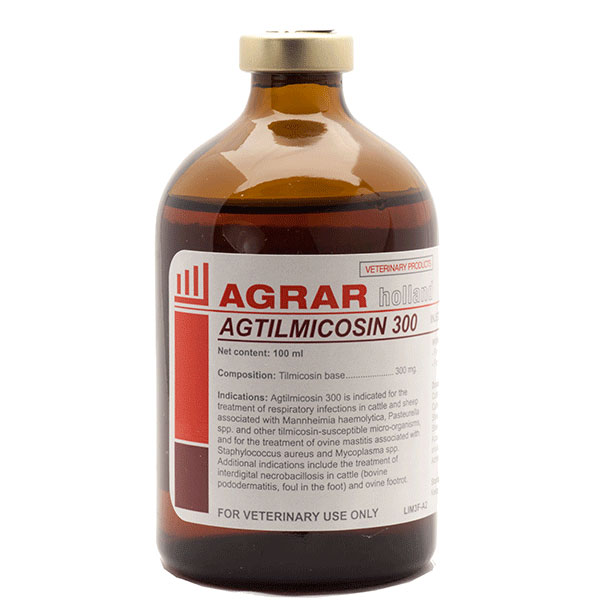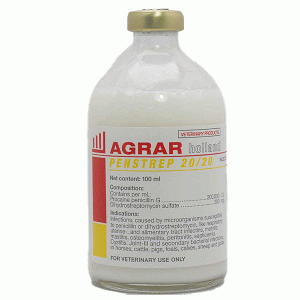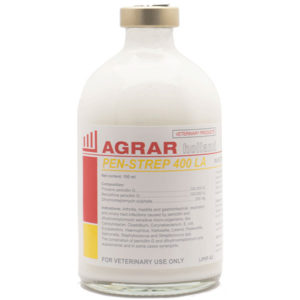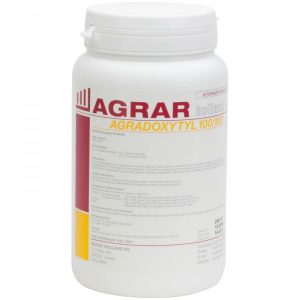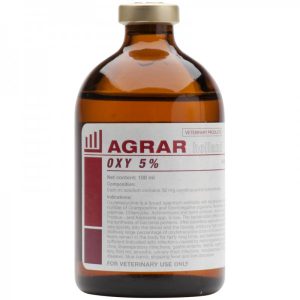Description
Composition:
Contains per ml:
Tilmicosin base 300 mg.
Excipients ad 1 ml.
Indications:
Tilmicosin is a broad-spectrum semi-synthetic bactericidal macrolide antibiotic synthesized from tylosin.
It has an antibacterial spectrum that is predominantly effective against Mycoplasma, Pasteurella and Haemophilus spp. and various Gram-positive organisms such as Staphylococcus spp.
It is believed to affect bacterial protein synthesis.
Cross-resistance between tilmicosin and other macrolide antibiotics has been observed. Following subcutaneous injection, tilmicosin is excreted mainly via the bile into the faeces, with a small proportion being excreted via the urine.
Agtilmicosin 300 is indicated for the treatment of respiratory infections in cattle and sheep associated with Mannheimia haemolytica, Pasteurella spp. and other tilmicosin-susceptible micro-organisms and for the treatment of ovine mastitis associated with Staphylococcus aureus and Mycoplasma spp.
Also indicated for the treatment of interdigital necrobacillosis in cattle (bovine pododermatitis, foul in the foot) and ovine footrot.
Contra-indications:
Hypersensitivity or resistance to tilmicosin. Concurrent administration of other macrolides, lincosamides or ionophores. Administration to equine, porcine or caprine species, or to lambs weighing 15 kg or less.
Administration to cattle producing milk for human consumption.
Intravenous administration.
During pregnancy, use only after a risk/benefit assessment by a veterinarian. Do not use in heifers within 60 days of calving.
Do not use together with adrenalin or β-adrenergic antagonists such as propranolol.
Side-effects:
Sometimes a soft diffuse swelling may occur at the injection site which subsides without further treatment. The acute manifestations of multiple injections of large subcutaneous doses (150 mg/kg) in cattle included moderate electrocardiographic changes accompanied by mild focal myocardial necrosis, marked injection site oedema, and death. Single subcutaneous injections of 30 mg/kg in sheep produced increased respiration rate, and at higher levels (150 mg/kg) ataxia, lethargy and drooping of the head.
Prolonged administration of high doses may result in renal, vestibular and/or auditory dysfunctions and sometimes hypersensitivity reactions may occur.
Dosage and Administration: Subcutaneous administration.
Cattle – pneumonia : 1 ml per 30 kg body weight (10 mg/kg).
Cattle – interdigital necrobacillosis : 0.5 ml per 30 kg body weight (5 mg/kg).
Sheep – pneumonia and mastitis : 1 ml per 30 kg body weight (10 mg/kg).
Sheep – footrot : 0.5 ml per 30 kg body weight (5 mg/kg).
Accurate weighing of animals is important to avoid overdosage. The diagnosis should be reconfirmed if no improvement is noted within
48 h. Administer once only.
Recommendations and Warnings:
Note: Exercise extreme caution and take appropriate measures to avoid accidental self-injection, since injection of this drug in humans can be fatal!
Agtilmicosin 300 should only be administered by a veterinarian.
Withdrawal time:
– For meat: Cattle : 60 days, Sheep : 42 days.
– For milk: Sheep : 15 days.
Storage: Keep in a cool and dry place, away from sunlight and safe from children.
Packing:
48 vials of 100 ml in 1 carton.
FOR VETERINARY USE ONLY
